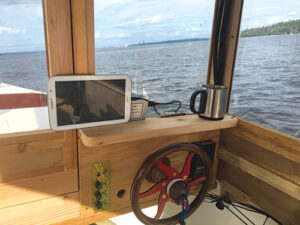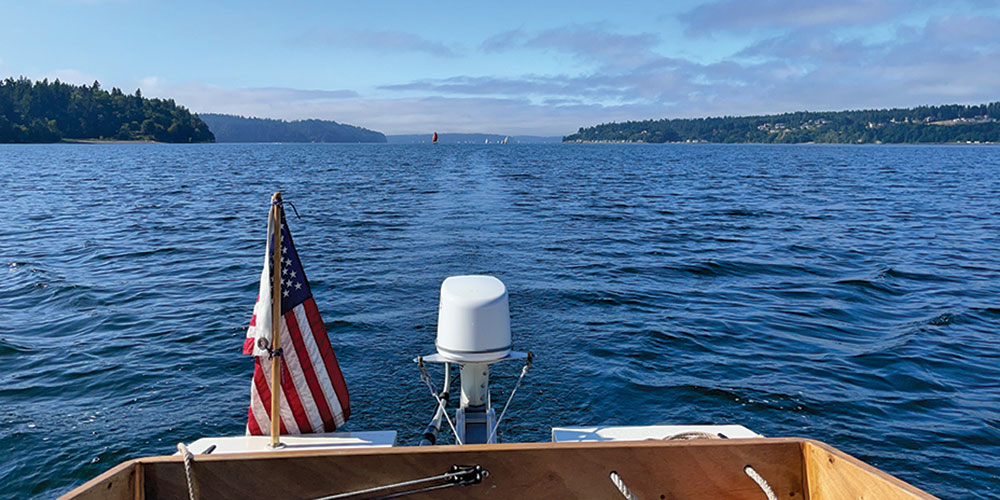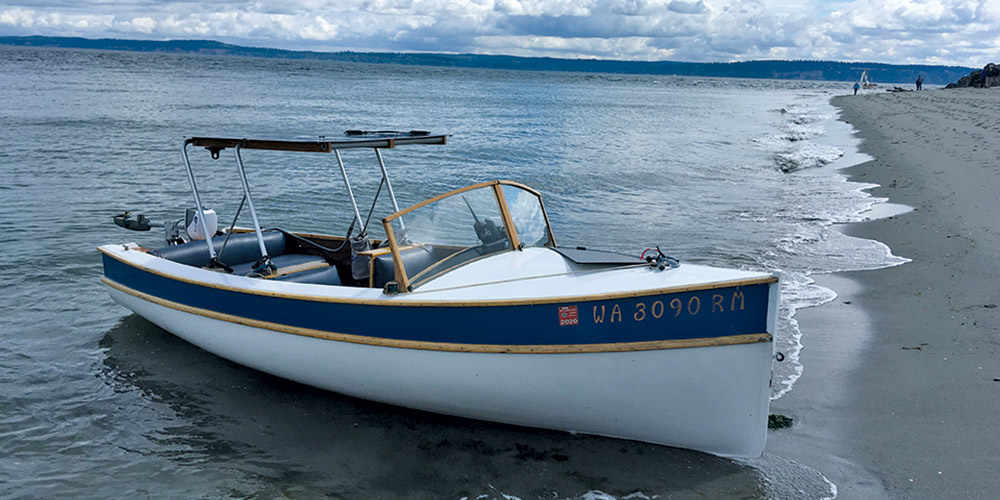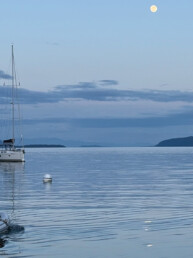Solar boating is an interesting combination of powerboating and sailing, but I think it has more in common with sailing… when there’s wind, at least. While it shares the comfort, lack of exertion, and simplicity of powerboating, a solar boat’s tank is refueled for free by the gas dock in the sky every day. While power boaters generally appreciate higher speeds, solar boaters experience speeds similar to a sailboat. Accordingly, sailors are more accustomed to aligning departures and routes with the tides and winds, which is similarly advised for a solar sailor. Sailors like using free energy from nature in real-time, and they especially appreciate a lack of exhaust and combustion noise, which are also benefits of solar boats. That gives you a general idea of what solar boating is all about, except for one more key point: when it’s dark, a solar boat is just an electric boat with range limitations, but as long as there is daylight—even if overcast and raining—you cannot be stranded with a solar boat.

Over the past decade, several new custom solar boats have been designed and built by local innovators. The cool thing about innovators is that they test new tech and report the results to the greater population. It’s a risky business because sometimes new ideas just don’t work; but either way, innovators separate fluff from substance for the rest of us. It’s safe to say, based on the performance reported thus far, that solar boating can appeal to, and meet the needs of, at least one segment of boating especially in the Pacific Northwest—long distance remote coastal cruising.

Having built my career in electronic product development, I installed my first electric marine motor about two decades ago, motivated to help my infant daughter avoid carbon monoxide fumes on our boat. It launched a new vocational passion, and I’m now the owner of a Pacific Northwest based manufacturer of small, electric outboard motors.
Thanks to this background, in 2014, I started providing custom electric racing motors to high school solar boat racing teams in California. One of these teams competed in the first international offshore solar regatta in Monaco, and I got to see the performance of advanced foil-borne solar racing boats up close. My first impression was that solar racing boats, while beautiful and graceful, are simply slow when compared to their high octane sisters. Solar boat racing is a safe and accessible class racing event, but solar racing boats will not compete in the unlimited hydro races any time soon.
There may be some advantages for solar lake boats with no dockside recharging infrastructure, and a solar kicker would be ideal for salmon trolling. But when you add it up, the most exciting application for solar boating belongs to coastal cruising.

Anybody who’s cruised a sailboat in the Pacific Northwest in July and August knows that the auxiliary tends to get more use than the spinnaker.
You will end your cruise with a tan, to say the least. If you are a displacement power cruiser, you know that fuel is up-charged at the gas dock and, when traveling remote, gas docks are far apart. Clogged fuel filters and engine problems are always a worry, and who likes the plume of diesel smoke covering an anchorage while you just want to enjoy a quiet cup of coffee as the sun rises. In contrast, solar boating is clean, quiet, and remarkably reliable electric boating (fewer moving parts to require maintenance and lubrication, known as a solid state system), but with an added daily refueling capability that works literally anywhere on the planet. To top it off, even in less-than-sunny conditions, summertime cruising speeds are still reasonable with solar.
In 2018, I completed my first solar performance modeling spreadsheet based on NOAA’s solar incidence model. This modeling tool provides a prediction for all-day cruising speeds and daily ranges in any location worldwide, under various sky conditions, and with any combination of boat hull resistance, battery, motor, and solar array sizing. This solar performance modeling tool shows that a well-designed solar propulsion system can provide performance that is in the neighborhood of combustion propulsion for long-distance displacement cruising applications on boats under 45 feet long.
CUSTOMIZING MY OWN SOLAR SAILORS
I used this tool when I configured Swe Pea—originally a hot-molded I-14 sailboat hull with a rotten transom—as a solar sailing boat. Swe Pea was finished just in time for the first 100-mile Salish 100 cruise from Olympia to Port Townsend in 2019. The setup was simple, with a standard EP Carry outboard with its 6-pound lithium battery, two 100-watt solar panels, and a solar charge controller. Without solar, Swe Pea’s range on her battery is only 6 nautical miles. But with solar, Swe Pea completed the full course, maintaining pace with the other wind and gas powered boats in the same size range, without ever recharging from the grid.
Actually, Swe Pea had more to give. So mid-trip, Swe Pea and I split from the pack for a 28-mile jaunt starting from Blake Island, through Rich Passage and Sinclair Inlet to the Port Orchard public dock for lunch, and then behind Bainbridge Island through Agate Pass and up to Kingston. The conditions were variable that day—intermittent sun and clouds early on, then from Agate Pass northward, thunderstorms, headwinds, and opposing tides. While I was a little worried about lightning on the water, I was never worried about range. It was a joy to visit the Port Orchard dock that, though in disrepair, still brought back memories of fishing and goofing around when I was a kid. And doing it using solar provided a quiet, restful trip (until the thunderstorm). I remember hearing the cavitation of the ferry prop through my hull in Rich Passage. I was alerted to seals and dolphins by the sound of their breath and jumping salmon by the sound of their takeoff. A seagull landed on the bow to say hi and didn’t leave a calling card. I was also pleased to verify on that trip that a balanced solar propulsion system can indeed eliminate the range-anxiety that plagues pure electric craft.

SOLAR BOATS PROVING VIABILITY
By now, I’ve collected data on several other small and larger solar boats including my own Sunnyside, 14-foot, 1,000-pound camp cruiser that I converted from a C-Lark sailboat hull. Sunnyside has a proven daily range of up to 40 nautical miles on a sunny day and 30 miles on an overcast day. Note: cloudy skies reduce solar generation to roughly 25% of the sunny potential; but on Sunnyside, reducing power output from full-on to one-quarter of the power consumption reduces actual speed only from 4.2 knots to 3 knots.
Two other local solar boats—Wayward Sun and Electric Philosophy—are Devlin design-builds with power systems specified by their owners, each with performance as impressive as their stories. Wayward Sun is a 27-foot monohull originally designed as a day boat, but was the first solar boat to travel the length of the Inside Passage. This historic trip is made more remarkable when considering that pandemic restrictions forbade her crew from stepping foot on Canadian soil. Wayward Sun’s performance is comparable to many combustion-powered displacement boats, particularly smaller cruising sailboats, with a top speed of 6.5 knots and a solar cruising speed of 4.5-5 knots. Overcast conditions prevailed during the trip, but she still accomplished the cruise on schedule.
Electric Philosophy, which was featured in the November 2021 issue of 48° North, is a 40-foot catamaran that can recharge faster from her expansive solar array than from mains at the dock. Her leisurely cruise speed is 6 knots but she can also cruise faster depending on the mood of her crew. Since first launching in 2021, she has traveled thousands of nautical miles, including a round trip to Alaska. At the time Editor Joe Cline stepped aboard for a ride with Electric Philosophy owners Ed and Eileen Pauley, they had been cruising for three months without plugging into shore power. And of course, they had no need to stop to refuel.
Wayward Sun and Sunnyside were designed with minimal battery capacity, requiring their skippers to leverage real-time solar power throughout the day. This is the budget approach, because batteries are expensive. However, I actually enjoy the process of adjusting power flow to the motor to match the power provided by the sun; increasing by morning to 100% throttle mid-day, and then slowing towards evening again. This method is not for everyone, but this is how you can maintain a 100% state of charge in the battery at all times. Alternatively, I enjoy guessing the throttle setting that uses some battery capacity in the morning, allowing the battery to charge as I continue motoring mid-day and then using some battery capacity again in the evening with the goal being to end up with the same state of charge at the end of day as when I began. When run this way, Sunnyside’s average speed is 3.7 knots on a sunny day, which is not a bad cruising speed for a 14-foot displacement hull.
Conversely, Electric Philosophy was designed with a much larger battery bank to enable cruising at higher speeds with rests in between to recharge. These examples at 14 feet, 27 feet, and 40 feet illustrate the expected practical capabilities of solar boats of various size and hull-type.
Here is a high level wrap-up of what we know about today’s solar powered cruising boats:
- With these three, plus other examples established, it is clear that solar is comparable to many combustion-powered vessels in terms of displacement cruising speeds. Range can be stated in two forms. One is a daily range, which can be estimated in the summertime by multiplying the speed of the boat by about 10 hours of run time. Daily range is where a combustion-powered boat wins. The other definition of range is as the upper limit of a boat’s fuel capacity, consumption, and mileage. The solar boat clearly takes this one, with infinite range by this definition.
- While it’s a good idea to consult an expert when designing your own system, mature components are now available in many sizes so anyone can commission a well-founded solar boat.
- Onboard solar panels are a fraction of the cost of a functionally equivalent battery bank, so unlike a pure electric boat, a solar boat saves up-front cost. For example, Sunnyside’s complete system including motor, battery, solar panels, charge controller, monitoring, house bank, remote steering, and remote throttle costs $2,750 at retail pricing—not much more than the cost of a functionally equivalent combustion setup. If Sunnyside were an electric boat with the same daily range but no solar, the cost would nearly triple due to the need for more battery capacity and a powerful dockside charger. My estimates show that with efficiencies of scale, well-designed solar boats will cost no more to build than an equivalent combustion-powered boat.
- A solar boat uses an electric drivetrain. Modern solid state electric systems require less maintenance and are more reliable than a combustion setup. Furthermore, lithium battery banks needed for solar propelled systems routinely last more than a decade and are affordable when replacement is needed due to their smaller capacity requirements. Finally, and obviously, solar eliminates fuel costs during a cruise.

IS SOLAR BOATING FOR YOU?
So, is solar-powered cruising for you? Simply put, the benefits of solar-powered cruising are valuable to those who like cruising at displacement boat speeds. You will be even more satisfied if you often travel long, remote passages where refueling is expensive, inconvenient, and sometimes unavailable; or you tire of the breakdown capacity and maintenance that accompanies combustion. Solar day boats are attractive to boaters who moor on a buoy or a private dock with no power to maintain a full charge. If you are an aging sailor like me, you will miss the excitement of a broad reach in a fresh breeze but will love the freedom from needing to navigate a surging foredeck to handle sails.

If this engages your imagination, the next question becomes: how long until you can switch to solar propulsion? That depends on your interest in being a trendsetter. Today, well-designed solar boats are still custom affairs and come with long design-build times, and custom prices. In other words, you can’t just go buy one and sail it away tomorrow. If you have the interest and money to be one of the first solar boaters, tech and components are ready now. If you value the tech element but are more interested in a stock design with many of the bugs worked out for you, you are an early adopter and will be able to choose a boat from a reputable builder in a few years. If you are not interested in tech, but still like the benefits, let some history happen before you jump in. Now that the concept has been demonstrated successfully for a range of boat sizes, proven mass-produced options should begin to appear in 6-8 years. For those who like the benefits of free, natural-energy-cruising but lack the funds to purchase a new boat, in 10-12 years it should be possible to find the first used solar boats on the market.
Having camp cruised in the company of dozens of other small boats over several years, I can say firsthand that solar-powered propulsion is a viable and rewarding way to go in this pursuit. The others mentioned in this article, however, demonstrate that the horizons are considerably broader. Solar-powered cruising comes with a level of independence that can only be matched by sailing (and then only when there is wind to be had; and solar-powered performance is statistically more predictable throughout a coastal cruise, even when faced with cloud cover).
For more information on long distance remote solar cruising, there are seminars at the Port Townsend Wooden Boat Festival and at the Seattle Boat Show that are worth attending. Sam Devlin Designs has completed several solar boat designs, and David Borton at Solar Sal makes a solar day boat on the East Coast. Though I can’t speak for other electric motor companies, I know that the one I’m involved in is enthusiastic about providing information about solar boating on smaller vessels, and I enjoy engaging with customers on the topic of solar and am happy to run predictions from my solar performance model for those interested.
The hardest phase of a new technology growth path is the innovator phase, and long distance remote solar cruising has made it. Keep a weather eye on solar sailing, the dawn of this form of boating is here.
A Real Life Solar Day Trip
A friend and I jumped in Sunnyside, my 14-foot solar electric converted sailboat, to circumnavigate Vashon and Murray islands in one day—a 38 nautical mile trip. A 14-foot solar boat is not fast, Sunnyside can maintain 4 knots over the water for 10 hours on a sunny day. On paper, that leaves no reserve range for this trip. However, we planned to leverage tides for another 5 miles of reserve, and I did bring extra batteries all charged up, just in case.
The trip started at 8:00 a.m. at the Point Defiance boat ramp. We transited up Colvos Passage on the outgoing tide, crossed the north end of the island at slack, and the plan was to ride the incoming tide south and back to Point Defiance by 6:00 p.m. that evening. Things evolved differently. Smoke from wildfires reduced our solar power by about 10%. We could not resist the urge to stop and fish for a few hours, causing us to pass the Point Robinson Lighthouse later than intended. On cue, a 15 to 20 knot breeze and matching seas built up from the south.
We could have pulled into Portage Bay and anchored for the night, but opted to continue. I think that choice was the only risk we took on this trip. If I were to do it again, I would have pulled in and anchored for the night. Nonetheless, we continued on, reaching Point Defiance right around dusk, hours behind schedule.
It was a great trip, but it does underscore some learnings specific to solar sailing. One is to track your plan and options when making a change, like stopping to fish, with a focus on making port by dark. In this case, we had sufficient charge for the remaining distance at reduced speeds but the weather intervened, which leads to the next lesson—we could have done a better job predicting the evening winds. Had we known this prevailing effect on those waters, we would have made better decisions earlier in the day. Another thing we learned is to not only watch tides and weather, but also track smoky skies in the summer that are becoming more common these days.
Finally, the safe plan is sometimes in conflict with the intended one. When foregoing an overnight in Portage Bay, I was influenced by the desire to make the circumnavigation, and thankfully it worked out. At the time, I must admit I was not sure. Next time, I’ll play it safe. My main takeaway from this trip, though, is simple: Get out there. This was an adventure worth having, with memories that will last.

Joe Grez has nearly 40 years of experience in product innovation and 47 patents. His company, PropEle Electric Boat Motors, manufactures the ultralight EP Carry electric outboard in Washington State. Learn more at www.electricpaddle.com. By the time you read this, he will have solar sailed another Salish 100.






